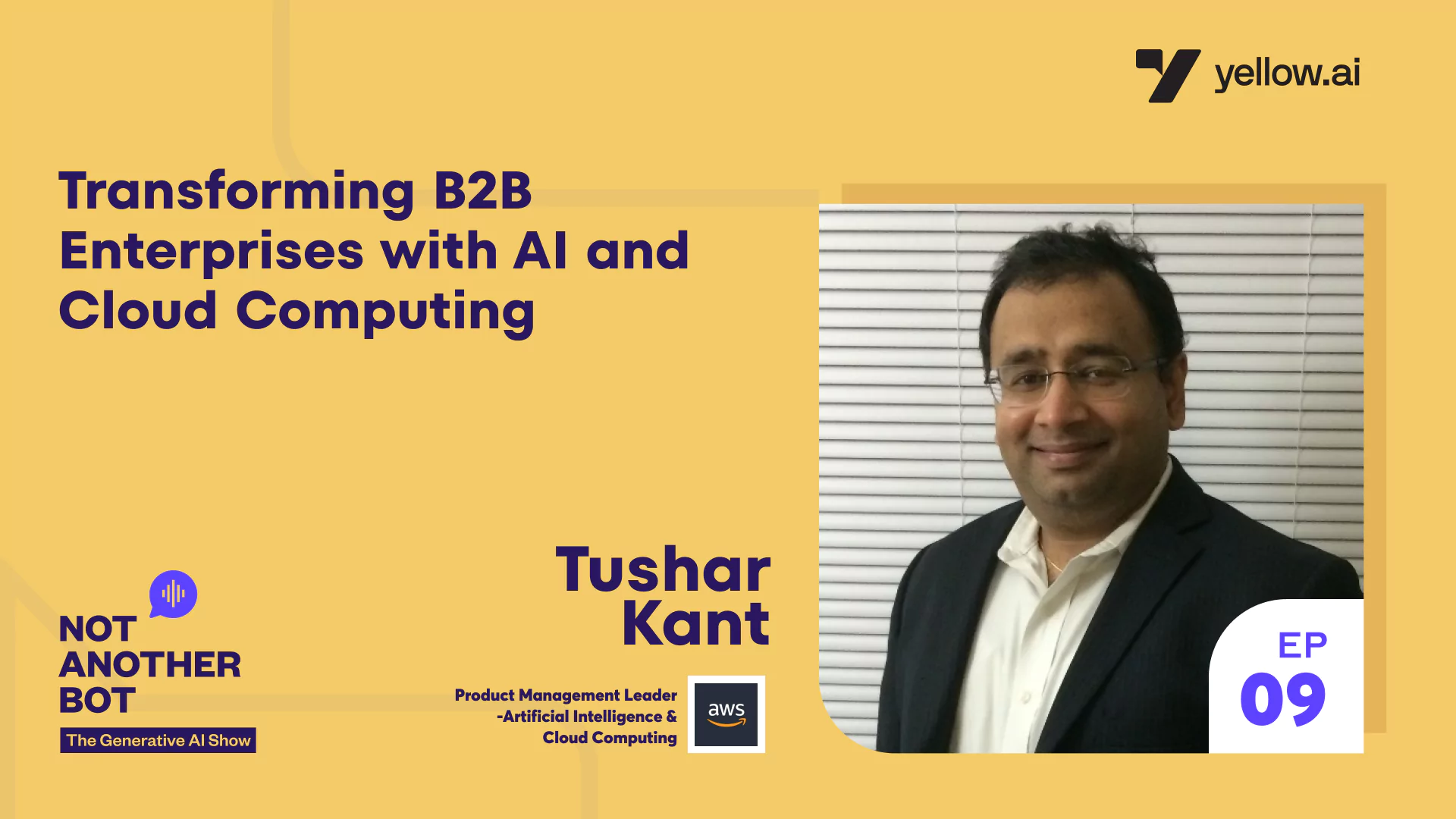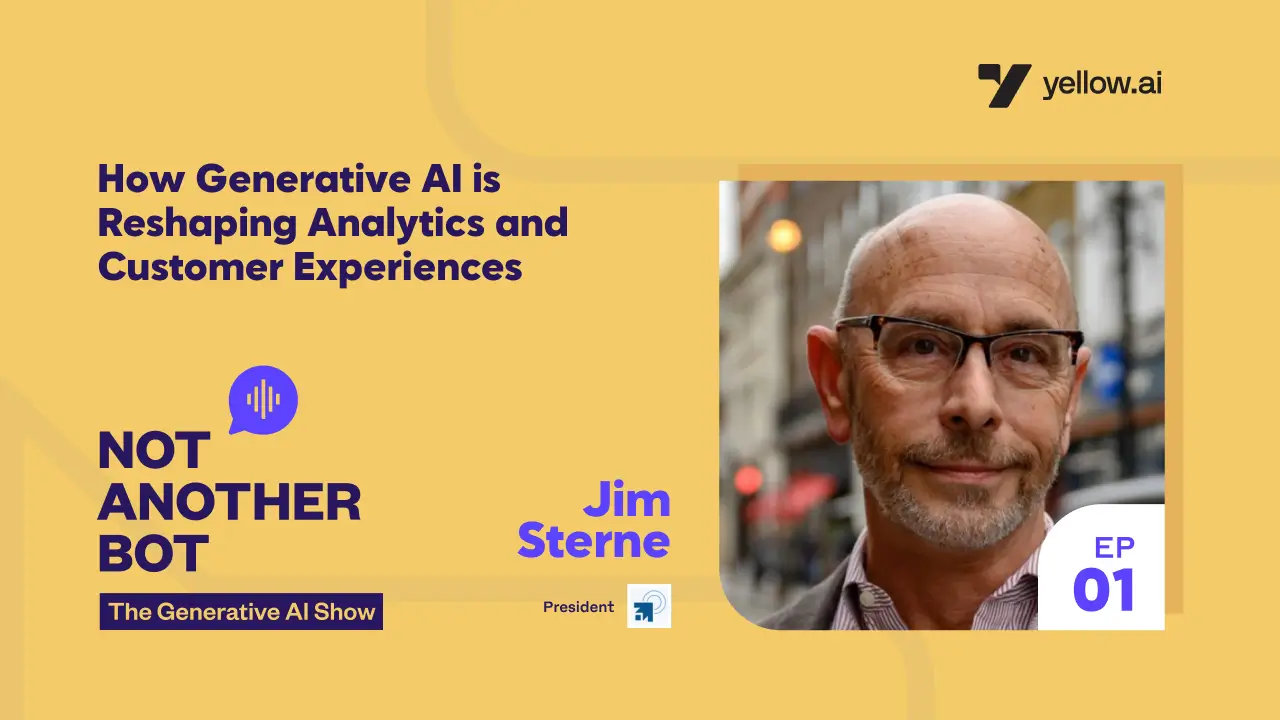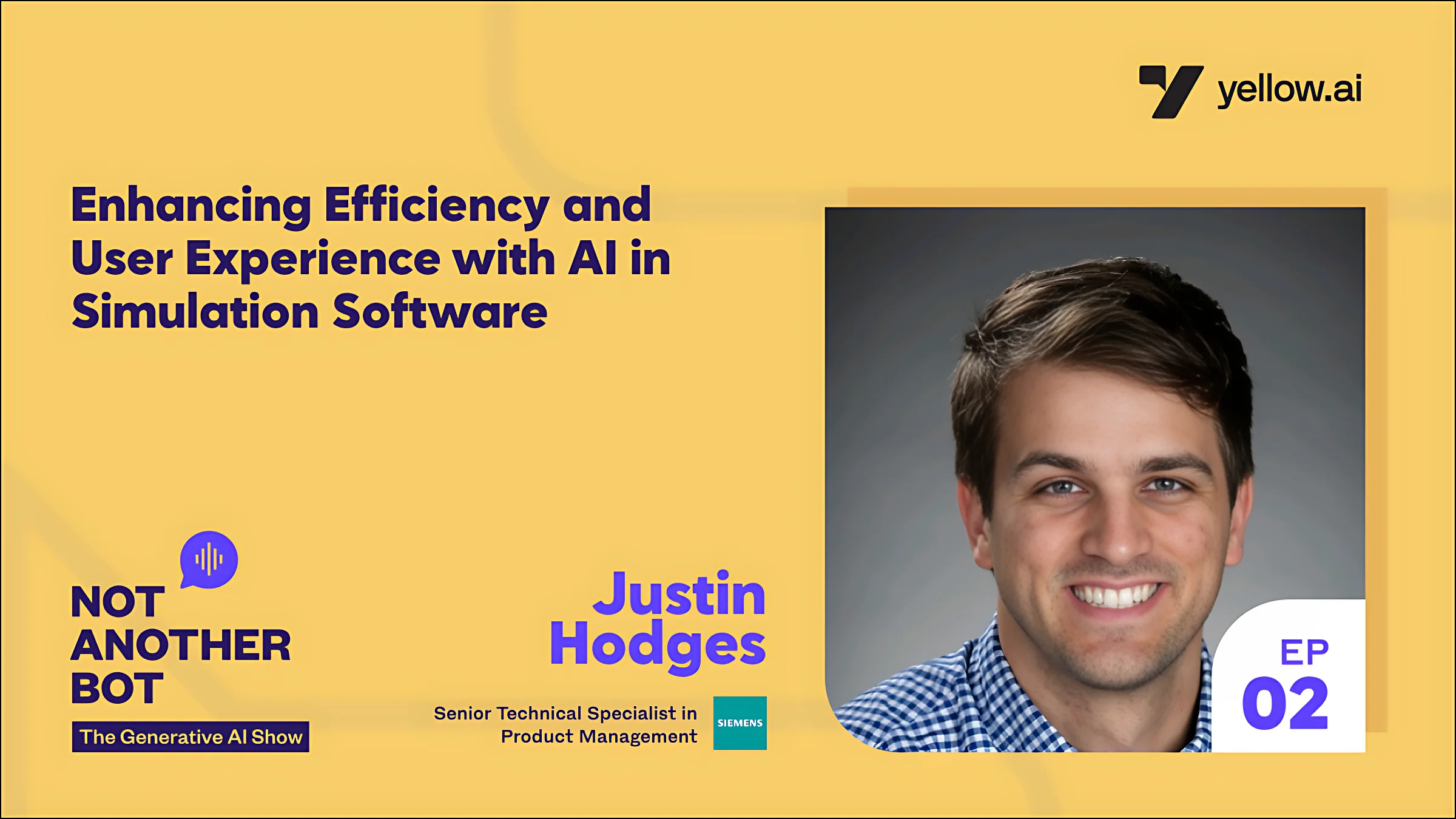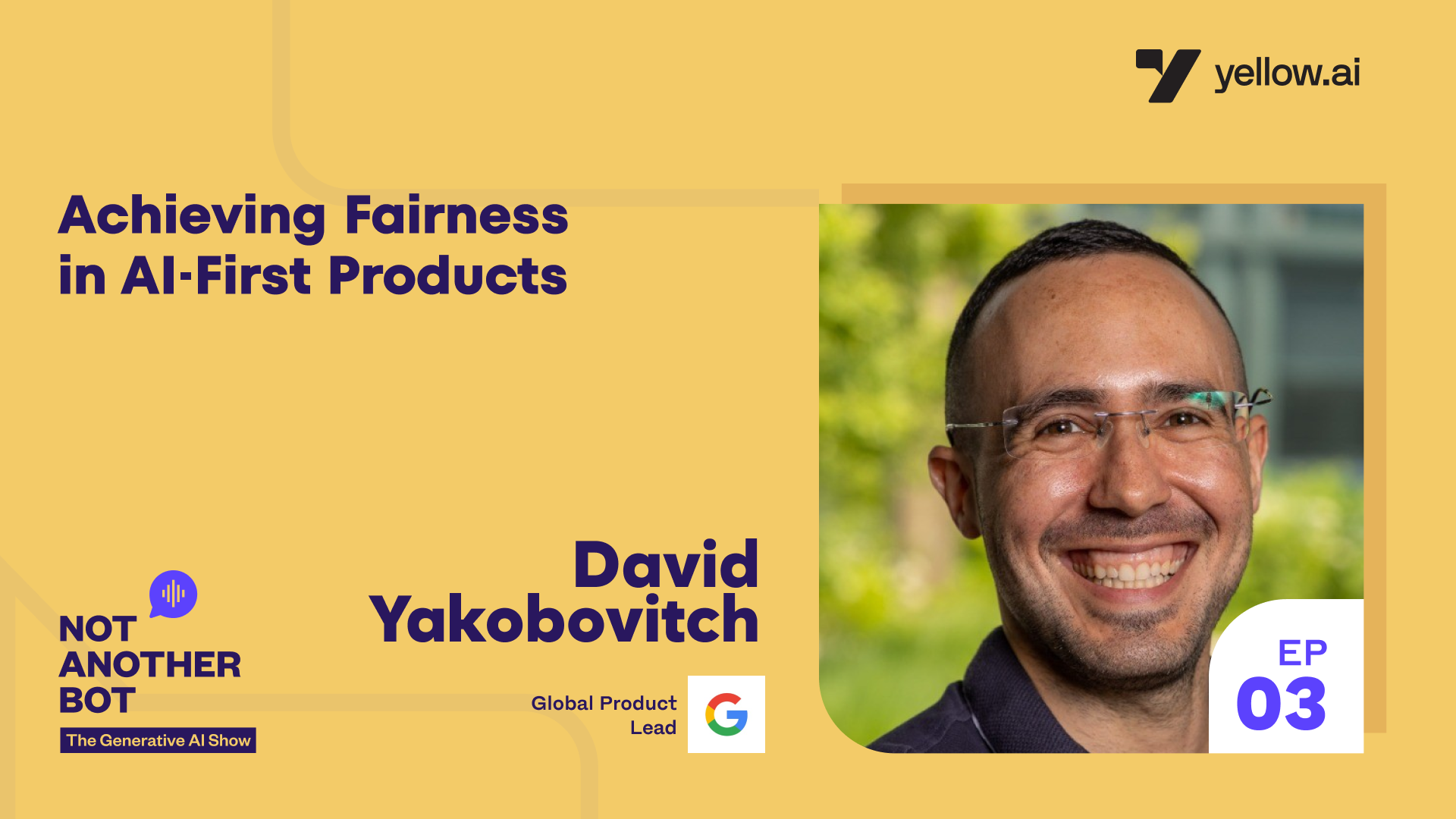Transcript
Intro – 00:00:03: Generative AI takes the center stage. But is your enterprise still watching from the sidelines? Come on in, let’s fix that. This is Not Another Bot, the generative AI show, where we unpack and help you understand the rapidly evolving space of conversational experiences and the technology behind it all. Here is your host, TJ.
TJ – 00:00:26: Hello and welcome to not another bot, the generative AI show. I’m your host TJ. Today we have the privilege of conversing with Tushar Kant, Director of Product Management, Generative AI, Artificial Intelligence and Cloud Computing at Amazon Web Services. He has also been the co-founder of the Global IIT Artificial Intelligence Forum. Hailing from a journey that has spanned Silicon Valley to Wall Street, Tushar’s two-decade career is a testament to his unparalleled expertise and passion for technological innovation. His leadership roles at industry titans like VMware and Facebook, coupled with his deep involvement in connecting AI enthusiasts globally through the IIT AI Forum, place him at the forefront of AI’s transformative impact on businesses. Welcome Tushar, intrigued to talk to you further.
Tushar Kant – 00:01:10: Thank you, welcome.
TJ – 00:01:12: Tushar, with almost two decades of experience across giants like AWS, VMware, Facebook, can you take us through your journey in the tech world and what drew you specifically towards Artificial Intelligence and Machine Learning?
Tushar Kant – 00:01:25: So, interesting thing is I started working in Artificial Intelligence 25 years back when the world was not even an industry norm. My undergrad thesis in IIT was Jaran Derax, NASA research scientist, in application of Artificial Intelligence to power systems. I was given a scholarship to do a master’s in computer science at University of Cincinnati, again focusing on Artificial Intelligence and machine learning. Under a faculty who is himself an IIT alumnus, where he published paper working with US Department of Defense. For that, I worked for six years as an engineer at Intel and Sun. So I have a good understanding of engineering works. Then I took a break, did a full-time MBA, was involved in street and private equity. I have a good understanding of a business’s work, our investments work from that perspective. Last eight to 10 years, I have spent building businesses in Cloud Computing and Artificial Intelligence at a host of companies in both public and private cloud, VMware, Amazon Web Services, Facebook, Twitter, Dell, you name it. Through my forum, I have had a chance to interact with roughly now 2,000 IIT alumni across the world. And we have done events in almost every conceivable area about application of AI to different verticals, as well as in terms of different use cases and technology. That’s the kind of background we are coming from. Genitive AI has certainly been something which I have been passionate about. Even before ChatGPT-3 came in three years back, I had a chance to do an exhaustive research of GPT-3 1, 2, and 3 papers that will publish by OpenAI. What has happened is it has democratized Generative AI. So I’m really happy to be here. I have built billion dollar businesses in enterprise sector. So happy to share my thoughts and experiences on how you can build businesses in enterprise sector, leveraging Generative AI, and the challenges associated with it.
TJ – 00:03:09: Absolutely. And to your point, so rightly said, you know, it’s not new, it’s just the way it’s been democratized and given to people to try out their hands on, right? I mean, GANs and VAEs are always there, but I think it’s just the way and the scale of NLP and specifically the Conversational AI aspect of it just completely changed the game. Well, over the years, Artificial Intelligence has evolved from a more theoretical point of view and concept to being a lynchpin in many business operations and giving you extensive experience in this domain. You can reflect on. So the most transformative impacts AI has had on B2B enterprises. And you can definitely touch upon generative AI if you may.
Tushar Kant – 00:03:48: When we talk about AI or Gen. AI, we have to first take a step back. The step back is for the enterprise to first think about their overall data strategy. How are they storing the data and structured data on-prem, colo, cloud? First of all, that has to be figured out. Like you would think about AWS as well. They first encourage customers to create a data lake using S3, which is an object store, right? Then you plug in tools on top of it to extract value out of data, to extract insight out of data. So AI and analytics or generative AI right now is something which is the second step in the process. What AI and Generative AI has done is. Analytics has done it, it is giving chance to enterprises to extract more value from the huge amount of data that they’ve collected over decades about their enterprise, customers, products, people. That is what is happening. Now, this has happened in three or four different stages. Initially, 10, 12 years back, when analytics started picking up Hadoop, Spark and all, that basically did help companies get some predictive information from the data. After that came in a little bit more on the analytics side, the video warehousing and the analytics kind of product which are coming in, help you get more idea or more information from analytics. When that was passed, it moved to Artificial Intelligence. When AI-related products started coming in, vision, be it natural language processing, be it analysis, right? And now that is going to an all different level with Generative AI. So essentially, it has been a journey with predictive prescriptive analytics, moving to AI, to generative AI, over a period of time. And going forward, it’s all about figuring out how to extract more value, more insights from the huge amount of data enterprises have collected over a period of time.
TJ – 00:05:33: Absolutely. And so rightly said, right? Without data, there’s no algorithm and certainly no machine learning. So, well, keeping to that topic and to what you just said, what are the potential pitfalls enterprises that need to be aware of when relying on heavily, especially on the AI-generated data for strategic decisions, Tushar?

AI has essentially been a journey with proactive prescriptive analytics moving to AI, to generative AI over a period of time, and going forward, it’s all about figuring out how to extract more value, more insights from the huge amount of data they have collected over a period of time


Tushar Kant
Product Management – AI and Cloud Computing, AWS
Head of Generative AI COE, FalconX Accelerator

Tushar Kant – 00:05:51: So the three parts to it, as you said, you used the word strategic decision. There is tactical level, there’s operational level, there’s tactical level, there is strategic level. At operational level, you know what data you have and you make day-to-day decisions moving things forward. That is perfectly fine. You look at the data, you do some analysis, you have to figure it out. At tactical level is where, and that can be done with statistical tools, analytical tools, any of these can easily work. At operational level, tactical level from operation, when you go there, therein comes your ability to basically look at things a little bit more broadly. And that’s where Artificial or basic artificial Intelligence comes into play. For example, if you look at a sales organization, right? At operational level, they can easily figure it out using simple statistics in analytics, which are the reasons which are meeting quota, what are the parameters which are changing, what’s going on, what should they do, what they should not do. Tactical level, they can figure it out. Hey, you know, what are the territories we should focus upon based upon past data? You have the customers who have done really good. How should we do be working with them? And you start thinking not in terms of weeks or days, start thinking in terms of quarters in a year or so, right? Strategic level, you’ve got to understand business much more deeply. And for that, for example, you do not need to just know. That your sales numbers changed from last quarter to this quarter, you’ve got to understand why did it change? Because that will give you a strategic insight into what’s going on in the business. Is it that the competitive dynamics has changed? Is it that fundamental customer approach towards things have changed? Is it because your products are not doing good? You got to go deeper into it. And a lot of tools which are coming up right now, leveraging, because for that you need to correlate data from multiple different sources, analyze them in real- time using really powerful systems, and then come up with something that can basically give you a deeper insight. That’s where LLMs are coming to picture. And that is basically making a lot of difference. So at a strategic level, you want to get to know a business much more deeply, much more insightful in a way. That’s where LLMs are coming into picture. At a tactical level, AI was sufficient. At an operational level, statistics is sufficient. That’s the way you have to look at it.
TJ – 00:08:03: So to continue from there, so how can generative AI be then utilized to create more tailored solutions? I think you touched LLM, so it could be very domain specific as well. So more tailored solutions and products for specific B2B industries. And just to add up, what are the challenges in ensuring that AI generated solutions? So continuing from what you just said, Tushar, how can generative AI be utilized to create more tailored solutions? Let’s say, you know, talking about LLMs, no more domain specific LLMs and products for specific B2B industries.
Tushar Kant – 00:08:35: So there are three parts to this whole game, inferencing, fine tuning and training. So the large language models, which OpenAI of the world and parts of the world are doing and creating in the cloud, right? That is basically focused more upon training the model. And every enterprise doesn’t need to train a model from scratch. They can take this model and use it directly for inferencing, for basic inferencing that they can do. Now, your question is how they can tailor it to their industry or company. For that, the concept of fine-tuning comes in where they can leverage their own data of the company to fine tune these models using vector databases and stuff like that. So you basically feed these models with data that you have for your own company to fine tune it based upon your own customers, your own competitive analysis, your own history of data, and that’s the way it’s going to work. So the bigger, now, some of these big enterprises, the JPMorgan and Pfizer of the world may decide to retrain their own model on their own. I would say that’s not the first step they will go in. They’ll first leverage some of these existing models to fine tune them for their own use cases and work from there.
TJ – 00:09:40: Interesting. And what are the challenges in ensuring that these AI-generated solutions meet very high standards required in the B2B space, especially if they are doing their own fine-tuning or picking up current foundational models, per se, Tushar?
Tushar Kant – 00:09:54: See, here’s the thing, right? Like any other system, what you need to do is you need to train and test these models thoroughly. So the validation process has to be exhaustive. And initially, you should think about leveraging these models for internal use, supporting their own customer support team folks or sales with the human in the loop, instead of using these models to build products that are basically going out to the public right away. So make sure that you basically figure out and use these models internally for your own users, let’s say supporting the consulting team, the support team, the sales team. Once you prove it over a period of time, then you should think about building products on top of it, which goes as a SaaS product or a platform as a service to the customers outside. That way, you kind of minimize your chances of goofing up to some extent. That’s the way you have to look.
TJ – 00:10:41: Interesting. If I may just take your mind for a second in terms of, Tushar, given with the evolution of generative AI, how do you see the entire aspect of going fully autonomous on things like customer support team, not only answering the basic questions, but extremely complex queries? We definitely on our end do see 80 to 90% automation now, especially with generative AI with some of the customers who just on-boarded. But I want to know, like, futuristically, I mean, do you see that most of these customer support team contact center-related stuff will become more fully autonomous, or you still feel the loop is still going to be a reality in a few years to come?

Like any other system, what you need to do is you need to train and test these models thoroughly. The validation process has to be exhaustive


Tushar Kant
Product Management – AI and Cloud Computing, AWS
Head of Generative AI COE, FalconX Accelerator

Tushar Kant – 00:11:19: The way I would look at it is, look at how support has changed, for example, when you make a phone call to your Services Provider. Be it wireless, cell phone, utility. Typically, you’re giving multiple options to choose from that are automated as much as possible. And if you get frustrated, you get a chance to hit zero talk to IEH. Now, so in case of customer support team and stuff, when you go online or you want to file a ticket, a lot of responses will start coming to you. Over a period of time, these models will become smarter based upon customers’ interaction with your model itself, that is the benefit of Artificial Intelligence and Feedback Loop System. However, you always will have the ability to resort to a human support at some point of time, everything else fails. That is the way this whole thing is going to evolve. Is it going to completely eliminate human in the loop? Absolutely not. Is it going to drastically bring down the number of people who actually are involved or needed in supporting these? That certainly is true. That’s the way the industry is going to evolve. And there is no reason why it’s not. There’s a huge amount of data, information, knowledge , runbooks books, which are already available, which can be used to train this customer support team systems. And that certainly is going to direct and it will go.
TJ – 00:12:32: Interesting. And just one anecdotal point from you, the human in the loop, especially agents versus human agents who are able to help and you dial that extra zero or you escalate a chat scenario. Do you think their role will evolve into more like AI operators who are just like full self-driving cars today? Overall, the human is now becoming more like a pilot. So they’re still giving more data points, but just the full autonomous aspect of it becomes, from a human standpoint, more AI operated. Is that something you would have any part of you on, Tushar? Just purely your thoughts on that as well.

Is AI going to completely eliminate humans in the loop? Absolutely not. Is it going to drastically bring down the number of people who actually are, you know, involved or needed in customer support roles, that certainly is true


Tushar Kant
Product Management – AI and Cloud Computing, AWS
Head of Generative AI COE, FalconX Accelerator

Tushar Kant – 00:13:08: The way I look at it is, I do not understand really the concept of AI operator, but the way I would look at it is the first line of defense, the L1 support, what you call, will be automated. Now, if that cannot be resolved, then at L2 level, you probably will need some kind of an human support to resolve at least or direct it in a certain way. That’s the way it will work. But the good news is, over a period of time, the systems will become so intelligent that we will not really need that much human support. Again, the beauty of AI-based systems is because of the Feedback Loop it continuously learns, like human beings themselves, they become much better over a period of time.
TJ – 00:13:46: Absolutely. Thank you so much for sharing those thoughts. Over to the next question. So as collaborative projects between businesses increase, Tushar. How can Generative AI facilitate seamless integration and enhance collaborative outputs? Can Generative AI be a game changer in merging data and insights from multiple B2B entities while ensuring data privacy?
Tushar Kant – 00:14:07: See, there are two or three different ways to look at it. Some of it is already happening without AI or Generative AI, and that is through API integrations and platform integrations. What Generative AI will do is, it will make it much faster, quicker. It will ensure that we can basically create common data platforms across enterprises with different views of data that they can look at, and then based upon that, you can extract insights from it. That’s the way it’s going to work. Now, in terms of API integrations and platform integrations itself, there are two parts to it. One is the models that are basically working, they can extract, use APIs to work with Generative AI and solutions out there in the models, right? But at the same time, when you are basically working on different APIs or different solutions, and let’s say, for example, you have a platform you’re building where you need to dynamically figure out which kind of product you need to align with, based upon customer’s inputs. You’re building a product like that. Something like Gen AI can be really quick in making those kind of real-time decisions and helping you move forward. From a data privacy perspective, as concerned, there is a whole game in itself. And that can be addressed to something called pseudo-anomalization, which is a process of basically anomalizing data in such a way that any kind of Personally Identifiable Information is taken out, so that even if the data falls into wrong hands, it’s okay and you can work with it. Some of that is already being addressed. It’s just that with Generative AI, a huge amount of data will come into full view by multiple parties. You have to make sure the system is much more robust. The needs and the demands have gone up. At the same time, the benefits have really come up. Think about this, right? It’s like a young kid who has just not learned how to ride a bike, right? A simple bicycle kind of a thing. He needs to be very careful. He needs to be wearing a helmet, and he needs to know how to go home to the park. Now he graduates to the level of driving a bike. He’s going to be driving a bike. He needs much more gear. He needs to feel much more secure. He needs to work from there. So the needs were previously there, but the magnitude will change.
TJ – 00:16:05: Interesting. I think one thing there is, as we kind of evolve on this journey and to your point, data privacy in itself is a big topic. From a perspective of enterprises adopting Generative AI, for sure. Is data privacy their first concern or they are looking more into things like hallucinations? They’re looking more into the use cases because spray is not going to work. You have to figure out the right use cases. You know where it’s starting and what are the points you would like to highlight there.
Tushar Kant – 00:16:35: I would say that first, forget about AI or Gen. AI. Think about your data strategy, creating a data lake. And when you’re creating the data lake, you have to do what is called Privacy by Design. So design it in such a way that it is private, by making sure the data templates and structures you’re using is in the right shape. Once that is done, then you should be thinking about models, whether it’s Generative AI or AI. Now you’re working on Generative AI, let’s say, chart with publicly available models. You do some inferencing. You work. If you think that this is giving you enough business value and has the potential to do that, then you should invest some resources to fine tune those models for your own use cases, for your own benefits and enterprises. And that way, it will be much more robust, to be much better. So first think about data separately, data strategy, data templates, and then think about Artificial Intelligence and think about Generative AI.
TJ – 00:17:25: And definitely bring Privacy by Design into your practices. Very, very rightly said. Awesome. So we at Yellow are very focused on customer support team, after sales service experiences and building excellent customer experiences is where our heart lies. And generative AI, it comes in very, very handy to make more human-like conversations a reality. So going back to that again, we touched upon it based on taking some thoughts from you on full autonomous, but going back to the core of it, right? How can B2B enterprises really harness Generative AI to revolutionize? Customer support team and after sales service experiences. And some part to that question would be the shower is, can Generative AI really bridge or can be used to bridge the understanding of the complex customer feedback and rapidly trading solutions?
Tushar Kant – 00:18:13: So first of all, the way you have to look at generative AI is not just in terms of after sales support or customer support team. Look at it as part of the overall customer journey. And so you should be collecting data about when the customer was onboarding, when you’re designing your product, and even after you do a customer sales and support, right? Now, a few key things you have to understand. Not only by building good automation to do customer service and support, you’ll enhance your customer experience and increase your retention, which is a big challenge in enterprises, right? Especially with things going on SaaS, subscripts and model customers can switch very easily, right? So leveraging, developing technology, which can basically help you iterate and make sure that your customer experience is very good. It’s going to help you retain customers. But there’s something else which is going on. Customer service and customer support team gets a lot of calls from customers, a lot of inputs from customers. How do you collect that information to help you design better products going forward? That’s a very powerful way. Companies like Trill, you have been looking into it. Microsoft has been looking into it. Where you look at not just in the terms of how to seduce customer support team and satisfy them, but if you see a larger pattern emerging, out of this, right? You got to make sure that you can understand those patterns, consider it like a customer feedback, and help that to improve your product, and let the customers know that you’ve acknowledged it. Acknowledge and let them know it, and that way you will build much better products over a period of time. There’s gardeners and foresters of the world are great and going to conferences, but when your customers are using the product, they’re telling you, these are the pain points which are not yet being addressed. Right. That’s the best way for you to improve your product. That’s the way you have to look. So look at the whole customer journey holistically in the whole lifecycle, and then think how that can basically work.
TJ – 00:20:02: Very nicely put together, Tushar. Thank you so much for calling it out. Going towards the next question and then we’ll start closing this podcast. It’s been amazing, Tushar, listening to you so far. As AI technologies evolve, Tushar, what do you foresee as the next big thing in generative AI for B2B innovations?
Tushar Kant – 00:20:20: You said next big thing in, that’s a very good question. You certainly have a very valid point, right? The way I’m looking at generative AI when it comes to B2B enterprises is, right now the low-hanging food would be customer support team and sales kind of stuff, right? But once companies land there, there’ll be a big land and expand strategy. Your companies will follow because you’ve already collected and got the mind-sayer of the enterprises, right? There’ll be Marketing Automation related stuff that will come into play. There’ll be sales and go to market related stuff which will come into play, but sales will be using Artificial Intelligence to get much better market reach. Salesforce is already coming up with products like Sales AI with predictive and generative AI capabilities, right? Your whole finance and accounting processes and systems can be automated to a great extent where you can predict challenges. And you’ll actually be looking at this data now from a strategic perspective, as you mentioned, which will be used. Developer productivity and engineering in product teams leveraging generative AI to a greater extent to improve the work that they are doing, not just using generative AI to build their product, but also for building a better developer experience and productivity that will come into play. So this land and expand will happen in B2B but many more other use-cases will actually come into play and customers will use it. And that’s the way we look at it, as generative AI really penetrating big B2B enterprises.
TJ – 00:21:39: Brilliant. Thanks, Tushar, for that. Well, I think towards the fag end of our podcast, the old question I have for you is, and this is like your closing thoughts precisely, as we look towards the horizon considering the potential of Generative AI and its implications for B2B enterprises. What would be your advice or prediction for organizations that are on the cusp of fully integrating generative AI into their operations?
Tushar Kant – 00:22:04: Who are basically on the cusp of it just to make sure that you do not put the card before the horse. So number one, make sure your data strategy is in place, make sure data privacy has been taken care of, make sure that you have very clear use cases that you have identified, that you’re going to be basically working with Generarive AI. You’ve tested your model thoroughly well before you basically put it out there in the masses and the crowd. That’s the way you have to look at it. So make sure all of these things have been put in place. Guardrails are there before you go full force.
TJ – 00:22:35: Tushar, it’s been a true pleasure talking to you. I think the way you explained every simple thing here, I shouldn’t say simple thing, the way you explained everything here in a simplistic way was just excellent. And to the point, I think I totally loved and enjoyed our conversation. I mean, on that note, we would love to definitely, you know, talk more for sure, Tushar. I mean, there’s so much to learn from experiences, but I really want to thank you for being here at the show today.
Tushar Kant – 00:22:59: Thank you. Have a great day. So let me know when you guys are ready. Would love to get a link, which I can share with my own alumni. And if you put it on social media, make sure you tag me. That way, we’ll talk about that. Thank you. And I would like to get a LinkedIn invite from you as well to stay connected.
TJ – 00:23:14: I will send that to you.
Tushar Kant – 00:23:17: Thank you, sir.
TJ – 00:23:18: How impactful was that episode? Not Another Bot: The Generative AI show, is brought to you by Yellow.ai. To find out more about Yellow.ai and how you can transform your business with AI-powered automation visit yellow.ai. And then make sure to search for the Generative AI Show in Apple Podcast, Spotify and Google Podcasts or anywhere else podcasts are found. Make sure to click subscribe so you don’t miss any future episodes. On behalf of the team here at Yellow.ai. Thank you for listening.





























